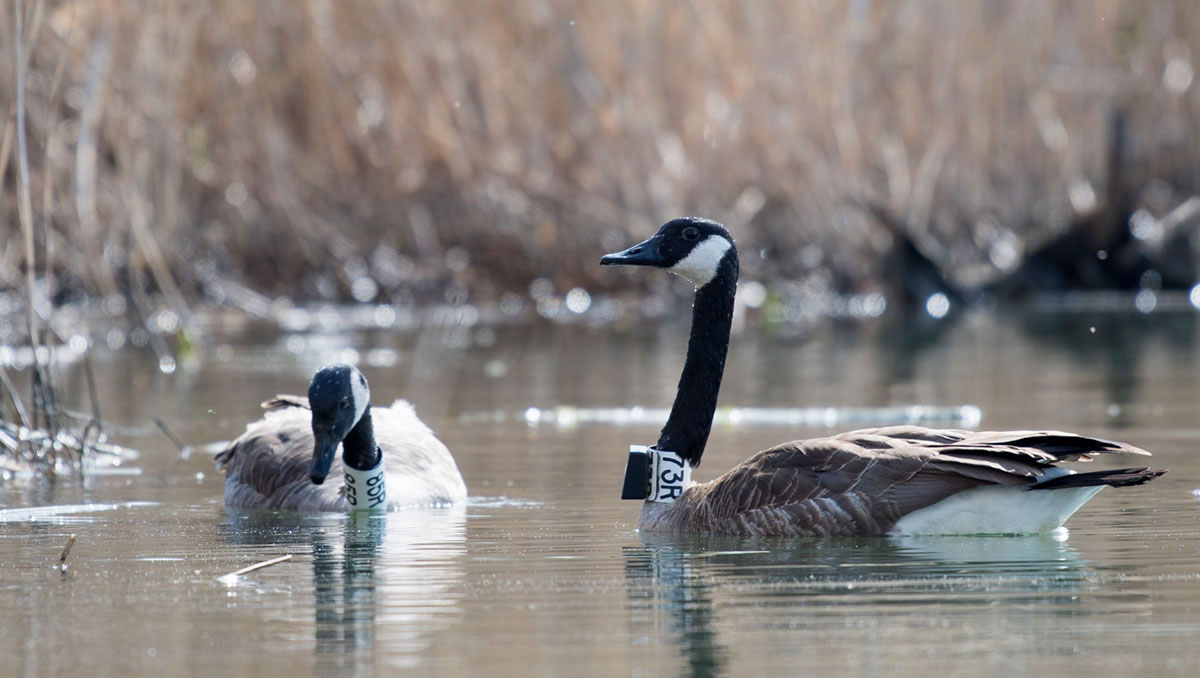
Transmittered Canada geese near Chicago.



Transmittered Canada geese near Chicago.
Few species of wildlife inspire the “love – hate” relationship as much as Canada geese. Canada geese are extremely popular as a game species with Illinois hunters harvesting approximately100,000 geese annually. Geese also are enjoyed by nature watchers across the state. The “hate” side is the risks Canada geese pose to aircraft, their aggressive behavior during the nesting season, and undesirable amounts of droppings on golf courses, beaches, parks and other recreational areas. The negative interactions between humans and geese continues to increase, mostly due to the increasing abundance of geese in urban and suburban areas.
We began a study 6 years ago in cooperation with Illinois Department of Natural Resources, the U.S. Department of Agriculture—Wildlife Services and Southern Illinois University to understand the ecology of geese in urban areas. The initial focus was to examine movement, habitat selection, and risk to air traffic during winter. We use neck collar-mounted GPS transmitters to provide insights into the life of Canada geese, capturing Canada geese in Chicago’s greenspaces (i.e. parks, cemeteries) using CO2 powered net launchers with a maximum range of 10 yards. Catching park geese has proved more difficult than one would think. During last fall geese quickly learned what we looked like in the areas where we were working; what clothes we wore and what vehicles we drove. Walking casually towards flocks wearing Carhartt bibs only worked for about a week. We switched to jogger camouflage; dark hooded sweatshirts and sweatpants to blend in with the regular park crowd. Even that ruse didn’t work for long.

After capturing a goose, we take measurements of the bird’s size, attach a standard aluminum leg band and a transmitter/collar around the birds’ neck. These transmitters collect GPS locations every hour and accelerometer data (think fit bit) every 15 minutes, and upload those to a database via the cellphone network every few days. With the location and fit bit data we are intending to address several questions associated with the most effective way to harass geese (i.e. what can be done to get them to move to another location), understand how geese are able to survive the cold, snowy winters at latitudes north of where they have traditionally wintered, and to investigate their movements throughout the region. For this article we will focus on the large movements of Canada geese.
If you live near a pond or wetland that host Canada geese it’s easy to think that they never migrate and simply stay year round. Many Canada geese do stay in the same region year-round, some remaining in the same area or site for long periods of time. However, the use of GPS transmitters led to an interesting finding. Geese transmittered in Chicago during winter often stay in that area to nest or travel north to breed in Wisconsin or Ontario. Geese that hatch young will raise their goslings and molt (drop all their flight feathers) close to where they nested. Those that don’t nest or whose nests get eaten by predators, may stay in the area, however many decided to engage in a long, unexpected journey.

We tracked approximately 30 Canada geese, even some breeding in downtown Chicago, to the northern reaches of Canada. Our transmitter-toting geese travel a 3,000+ mile journey to the northern Hudson Bay, sometimes going from dodging cars on Lake Shore Drive to avoiding being eaten by polar bears in a few days. The reason geese make this journey, including a treacherous flight back during hunting season, is still unclear. However, this migration by Canada geese (often referred to as molt migration) is likely related to lower disturbance/risk from predators, competition with socially dominant family groups, or a better foraging environment (i.e. longer days, better food).
We will continue collecting and analyzing data on the movements and behavior of geese. While we can’t promise to find the “magic bullet” to keep geese off your yard or favorite golf course we have learned a great deal about this “majestic” creature. We expect to gain a better understanding of factors driving success of geese in urban areas and the best management practices to reduce human-goose conflict.
Ryan Askren is a PhD student with the University of Illinois’ Illinois Natural History Survey and has been working on the Canada goose project since January 2017. He grew up in the outdoors and has had a love for waterfowl hunting, birding and photography since a young age. He has a beautiful wife, a Labrador, and two worthless labradoodles. He enjoys wearing damp waders and believes Canada geese are the most majestic of all the birds.
Dr. Michael Ward is an associate professor with the University of Illinois and senior ornithologist with the Illinois Natural History Survey. Dr. Ward is involved with a large number of collaborative research projects with foci on avian ecology and behavior.
Submit a question for the author
Question: Many people don’t like geese but I love them.
Some people are afraid of them but they are gentle unless they have gosling nearby. I.love
Birds and I have a pet African Grey parrot who is 22 years old.